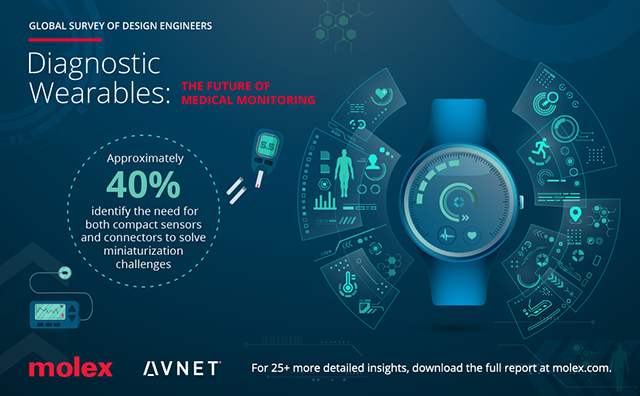Telehealth and Homecare Will Aid the Adoption of Wearables
A new survey of electronic device design professionals shows that trends such as remote patient monitoring will help drive the adoption of wearable health devices, but other factors will also influence their use and design.
- By David Kopf
- Sep 27, 2022
Healthcare trends such as telehealth and increased delivery of care to patients in the home will drive the adoption of wearables health devices, according to a new global survey.
Wearable health devices that facilitate the monitoring of real-time patient health data to better understand and manage their care will continue proliferating as long as they get past some market and design obstacles, according to Diagnostic Wearables: Future of Medical Monitoring.
Sponsored by healthcare electronics company Molex and its partner electronics distributor Avnet and conducted by market research firm Dimensional Research, the study surveyed more than 600 electronic design professionals involved in developing wearable diagnostic solutions.
Respondents to the survey cited various factors as influencing innovation in wearables:
- Technology innovation – 54 percent
- Greater adoption of telehealth and remote patient monitoring – 47 percent
- Patient and caregiver demand for self-diagnostics – 40 percent
- Increased delivery of care in the home – 31 percent
- Entrance of consumer electronics companies (i.e., Apple) into the medical device market – 30 percent
- Shortage in skilled healthcare workers – 27 percent
- Increasingly difficult regulatory hurdles – 18 percent
- Changing reimbursement paradigms (i.e., outcomes-based payment) –12 percent
Underscoring the responses on telehealth and remote management, 61 percent of survey-takers said that because of the Covid-19 pandemic, medical device companies explored more products that could be used home-based care, and 55 percent noted that patients became more open to self-administered testing because of the public health emergency.
That said, there are some key factors that will shape the development and adoption of wearable health devices:
- 99.7 percent reported that ease of use for patients and user interface demands will create design challenges.
- That said, 46 percent said making design trade-offs to meet user demands and still deliver devices to market is getting easier.
- 94 percent said that wearable diagnostics require clear ownership of data security and privacy
To learn more, download a PDF of the full report.

About the Author
David Kopf is the Publisher HME Business, DME Pharmacy and Mobility Management magazines. He was Executive Editor of HME Business and DME Pharmacy from 2008 to 2023. Follow him on LinkedIn at linkedin.com/in/dkopf/ and on Twitter at @postacutenews.